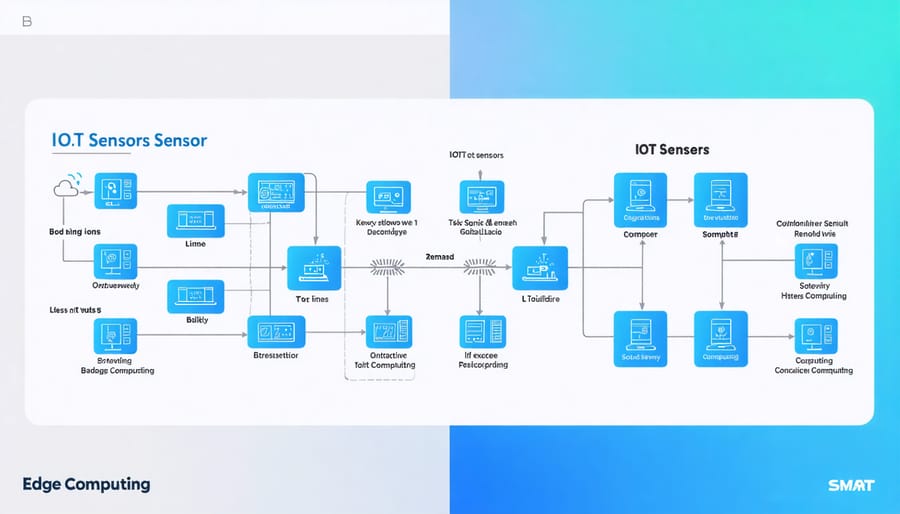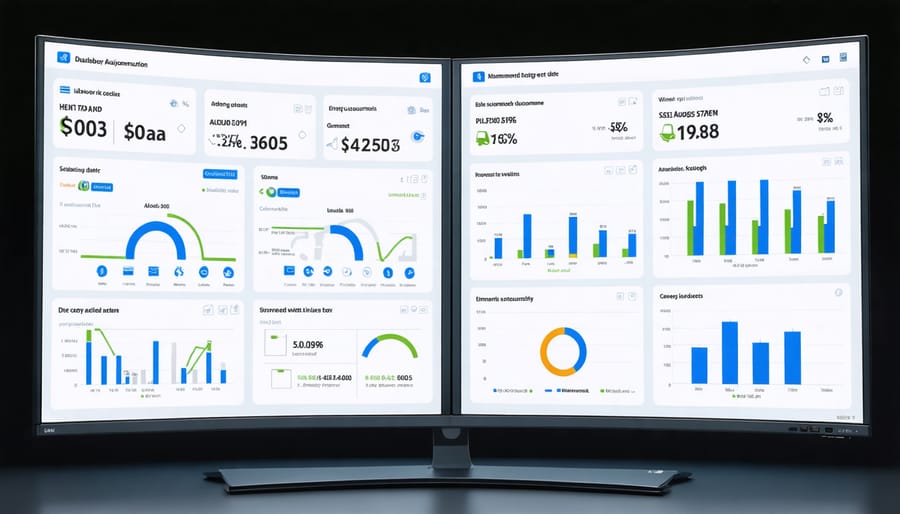Edge analytics is revolutionizing how modern buildings operate, shifting from traditional cloud-based systems to real-time, on-site data processing that delivers immediate insights and actions. By processing sensor data directly within building systems – from HVAC controls to occupancy monitors – facility managers can now make split-second decisions that optimize energy usage, enhance occupant comfort, and reduce operational costs without the latency of cloud computing.
This transformation comes at a critical time when smart buildings generate terabytes of data daily. Traditional centralized analytics simply cannot keep pace with the volume and velocity of information flowing from thousands of connected devices. Edge analytics solves this by distributing processing power throughout the building infrastructure, enabling instantaneous responses to changing conditions while reducing network bandwidth requirements and storage costs.
For facility managers and building owners, this means more efficient operations, predictive maintenance capabilities, and enhanced security through faster threat detection. Real-world implementations have demonstrated up to 30% reduction in energy consumption and 25% decrease in maintenance costs when edge analytics are properly deployed. As we continue advancing toward truly intelligent buildings, edge analytics stands as the cornerstone technology enabling the next generation of smart building operations.
The Power Shift: From Cloud to Edge Analytics in Smart Buildings

Real-Time Decision Making at the Source
Edge analytics transforms how building systems process and act on data by enabling instant decision-making right where data is generated. Unlike traditional cloud-based analytics that require data transmission to remote servers, IoT sensors in smart buildings can now process information and execute responses in milliseconds, dramatically improving system responsiveness and efficiency.
This immediate processing capability proves crucial in scenarios requiring split-second decisions, such as adjusting HVAC systems based on sudden occupancy changes or responding to security incidents. Edge devices equipped with sophisticated algorithms can automatically analyze sensor readings, identify patterns, and implement predetermined responses without waiting for central system approval.
Consider a smart building’s ventilation system detecting a sudden CO2 spike in a conference room. Traditional systems would send this data to the cloud, wait for analysis, and then receive instructions – a process that could take several seconds or even minutes. With edge analytics, the local processor immediately recognizes the condition and adjusts airflow parameters, ensuring occupant comfort and safety without delay.
Reduced Latency, Enhanced Performance
Processing data at the edge significantly reduces the time between data collection and actionable insights in smart building operations. By analyzing sensor data locally, edge computing eliminates the need to transmit large volumes of information to centralized servers or cloud platforms, resulting in near-instantaneous response times for critical building systems.
This reduced latency proves particularly valuable in applications requiring real-time decisions, such as HVAC adjustments, occupancy-based lighting control, and security monitoring. For instance, when occupancy sensors detect changes in space utilization, edge processors can immediately adjust environmental controls without waiting for cloud-based analysis, improving both energy efficiency and occupant comfort.
Performance improvements also stem from optimized bandwidth usage and reduced network congestion. By filtering and processing data locally, edge analytics transmit only relevant insights rather than raw data streams, ensuring more efficient network utilization. This distributed processing approach enables buildings to maintain optimal performance even during network disruptions or high-traffic periods.
Additionally, edge computing’s local processing capability supports more sophisticated analytics without compromising response times, enabling advanced building automation features like predictive maintenance and dynamic resource allocation.
Critical Applications in Smart Building Operations
Energy Management and Optimization
Edge analytics plays a crucial role in achieving significant energy cost reduction through real-time monitoring and optimization of building systems. By processing data directly at the source, edge devices can instantly analyze energy consumption patterns and make immediate adjustments to HVAC systems, lighting, and other power-consuming equipment.
The implementation of edge analytics enables buildings to respond dynamically to changing conditions. For example, occupancy sensors connected to edge devices can automatically adjust ventilation rates based on real-time demand, while smart meters can detect and respond to power quality issues instantaneously. This rapid response capability eliminates the latency associated with cloud-based systems and reduces unnecessary energy consumption.
Recent case studies have demonstrated that buildings utilizing edge analytics for energy management achieve 15-30% greater efficiency compared to traditional building management systems. The technology enables microsecond-level decisions about energy distribution, load balancing, and equipment operation schedules.
Advanced edge analytics platforms can also predict maintenance needs and optimize equipment performance by analyzing operating parameters in real-time. This predictive capability helps prevent energy waste from malfunctioning systems and ensures that all building components operate at peak efficiency levels. The combination of immediate response capabilities and predictive analytics creates a comprehensive approach to energy management that maximizes both sustainability and cost savings.

Predictive Maintenance and Asset Management
Edge analytics has revolutionized how construction and facility management teams approach equipment maintenance and asset management. By processing data directly at the source, modern predictive maintenance solutions can detect potential equipment failures before they occur, significantly reducing downtime and maintenance costs.
Real-time sensor data from critical equipment, such as HVAC systems, elevators, and industrial machinery, is analyzed instantly at the edge, enabling immediate response to anomalies. This approach eliminates the latency associated with cloud-based processing and reduces bandwidth consumption, making it particularly valuable for large-scale construction sites and building complexes.
Edge-based predictive maintenance systems typically employ machine learning algorithms that learn from historical performance data to identify patterns indicating potential failures. These systems monitor key parameters such as vibration, temperature, power consumption, and acoustic signatures, providing maintenance teams with actionable insights through mobile dashboards and automated alerts.
Implementation success stories demonstrate substantial benefits, including a 30% reduction in maintenance costs and a 45% decrease in unexpected equipment failures. For example, a major commercial building in Singapore implemented edge analytics for its chiller systems, resulting in energy savings of 20% and extending equipment life by an estimated 25%.
Occupancy-Based Environmental Control
Modern buildings are becoming increasingly intelligent through the integration of occupancy-based environmental control systems that leverage edge analytics. These systems use a network of IoT sensors to detect real-time occupancy patterns and automatically adjust HVAC, lighting, and ventilation settings accordingly.
By processing occupancy data directly at the edge, buildings can respond instantly to changing conditions without the latency associated with cloud-based systems. Smart sensors detect movement, heat signatures, and CO2 levels to create accurate occupancy maps of different zones within the building. This granular data enables precise control of environmental parameters on a room-by-room basis.
For example, when sensors detect that a conference room is empty, the system automatically adjusts temperature setpoints and dims lights to conserve energy. When occupants enter, conditions are quickly optimized for comfort. This dynamic response not only improves energy efficiency but also enhances occupant comfort and productivity.
Case studies have shown that occupancy-based environmental control can reduce HVAC energy consumption by 20-30% and lighting energy usage by up to 50%. Advanced systems can even learn from historical patterns to predict occupancy trends and pre-condition spaces before they are needed.
The real-time nature of edge analytics is crucial for these systems, as even minor delays in environmental adjustments can impact both energy efficiency and occupant comfort. This technology represents a significant advancement in smart building automation, offering both operational savings and improved indoor environmental quality.
Implementation Challenges and Solutions
Security and Data Privacy Considerations
As edge computing becomes increasingly prevalent in construction and building management, implementing robust smart building security measures is paramount. Edge devices processing sensitive building data must be protected against both physical and cyber threats. This includes implementing end-to-end encryption for data transmission, secure authentication protocols, and regular security audits of edge devices and their connections.
Physical security of edge devices demands careful consideration, particularly when deployed in accessible areas. Tamper-proof enclosures, secure mounting solutions, and restricted access protocols should be standard practice. Additionally, implementing network segmentation helps isolate edge devices from the broader building network, minimizing potential attack surfaces.
Data privacy compliance is another critical consideration, especially when processing occupancy data or personal information. Edge computing actually enhances privacy by processing sensitive data locally, reducing the need for cloud transmission. However, organizations must still ensure their edge analytics implementations comply with relevant data protection regulations and industry standards.
Regular firmware updates, security patches, and vulnerability assessments should be incorporated into maintenance schedules. Building managers should also maintain detailed documentation of all edge devices, their security configurations, and incident response procedures to ensure quick resolution of any security issues that may arise.
Integration with Legacy Building Systems
Integrating edge analytics with legacy building systems presents both challenges and opportunities for modern facilities. The key to successful integration lies in creating a seamless bridge between existing infrastructure and new edge computing capabilities while maintaining operational continuity.
Most legacy buildings utilize traditional Building Management Systems (BMS) that operate on older protocols such as BACnet, Modbus, or LonWorks. To incorporate edge analytics, organizations typically employ protocol converters and IoT gateways that can translate data between legacy systems and modern edge devices. These gateways act as intermediaries, enabling real-time data collection and analysis without requiring a complete system overhaul.
A layered approach to integration has proven most effective. The first layer involves installing smart sensors and edge devices alongside existing equipment. The second layer consists of edge computing platforms that process data locally, while the third layer manages communication with the central BMS. This strategy allows organizations to maintain their current infrastructure while gradually adding advanced analytics capabilities.
For optimal results, facility managers should:
– Conduct thorough system audits to identify integration points
– Implement middleware solutions for seamless data exchange
– Use edge devices with multiple protocol support
– Maintain redundancy systems during integration
– Deploy robust cybersecurity measures to protect both legacy and new systems
When properly executed, this integrated approach enables facilities to leverage modern analytics capabilities while maximizing the value of existing infrastructure investments.
Future-Proofing Smart Buildings with Edge Analytics
AI and Machine Learning at the Edge
The integration of AI and machine learning capabilities at the edge represents a significant evolution in building analytics, enabling real-time decision-making without the latency of cloud-based processing. Modern edge devices now incorporate sophisticated neural networks and machine learning models that can process sensor data instantly, identifying patterns and anomalies in building operations as they occur.
These AI-enabled edge devices can perform complex tasks such as occupancy prediction, energy optimization, and equipment fault detection with increasing accuracy. For example, smart HVAC systems can now learn from historical usage patterns and environmental conditions to optimize temperature controls automatically, reducing energy consumption while maintaining comfort levels.
The advancement in edge AI processing power has made it possible to run previously cloud-dependent applications locally. Modern edge devices can handle computer vision applications for security monitoring, natural language processing for voice-controlled building systems, and predictive maintenance algorithms that anticipate equipment failures before they occur.
One notable development is the emergence of federated learning, where edge devices can collaborate to improve their AI models while maintaining data privacy. This approach allows building systems to benefit from collective intelligence without compromising sensitive operational data.
As edge AI continues to evolve, we’re seeing increased capabilities in automated decision-making, with systems capable of managing complex building operations autonomously while only escalating unusual situations to human operators. This progression marks a significant step toward truly intelligent buildings that can adapt and respond to changing conditions in real-time.

Scaling Edge Analytics Across Building Portfolios
Implementing edge analytics across multiple buildings requires a strategic approach that balances standardization with flexibility. Organizations managing large property portfolios must first establish a scalable infrastructure that can accommodate varying building sizes, systems, and operational requirements.
A successful scaling strategy typically begins with pilot deployments in representative buildings to validate the technology and processes. These initial implementations serve as templates for wider rollout, providing valuable insights into potential challenges and optimization opportunities. Key considerations include standardizing hardware specifications, establishing consistent data collection protocols, and developing unified analytics frameworks that can be replicated across properties.
Network architecture plays a crucial role in portfolio-wide deployments. Organizations should implement a hierarchical edge computing structure where building-level analytics feed into regional hubs, enabling both localized decision-making and portfolio-wide insights. This approach optimizes bandwidth usage while maintaining system responsiveness.
Security and maintenance considerations become increasingly complex with scale. Implementing automated deployment tools, remote monitoring capabilities, and centralized security protocols helps manage this complexity. Organizations should also establish clear guidelines for data governance, ensuring consistent handling of sensitive information across all properties.
Cost optimization in large-scale deployments often involves standardizing hardware selections, leveraging bulk purchasing power, and developing efficient maintenance protocols. Success stories from leading property management firms demonstrate that economies of scale can significantly reduce per-building implementation costs while improving overall operational efficiency.
Edge analytics represents a paradigm shift in smart building operations, offering unprecedented capabilities for real-time decision-making and operational efficiency. By processing data directly at the source, organizations can achieve faster response times, reduced bandwidth costs, and enhanced security. The successful implementation of edge analytics requires a strategic approach, combining the right hardware infrastructure, scalable software solutions, and skilled personnel. As smart buildings continue to evolve, edge analytics will play an increasingly crucial role in enabling predictive maintenance, optimizing energy consumption, and improving occupant comfort. Forward-thinking construction professionals should prioritize edge analytics integration in their building designs, ensuring their projects remain competitive and future-ready in an increasingly connected world. The investment in edge analytics today will undoubtedly yield significant returns through improved building performance, reduced operational costs, and enhanced sustainability metrics.

